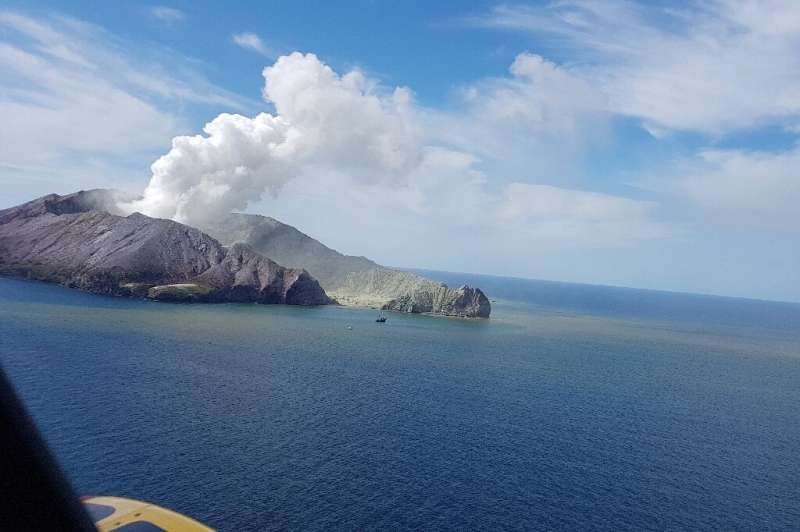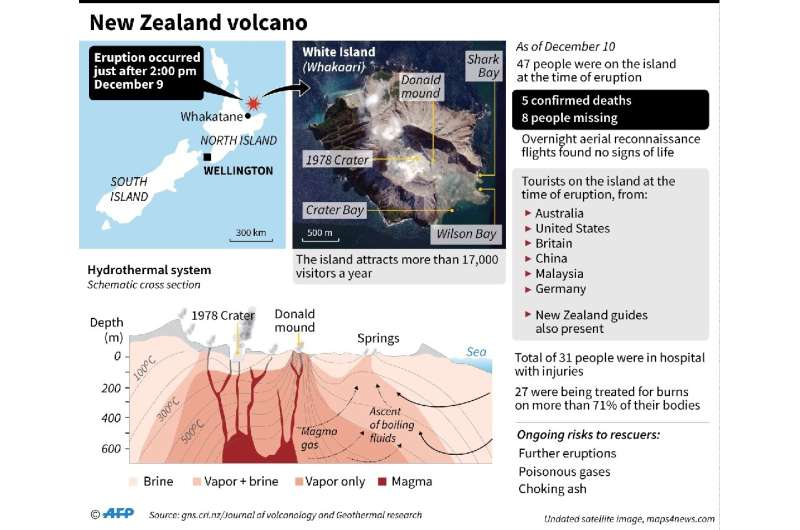According to New Zealand authorities there has been a steady decline in activity at the volcano on White Island but it remains unpredictable, with minor eruptions ongoing
New Zealand's White Island exploded suddenly on Monday and almost instantly became the scene of unimaginable horror, but as the country's most active volcano a disaster was not entirely unexpected.
Here are four key questions about the December 9, 2019 eruption and the volcano that caused it:
What happened?
The eruption began at 2.11pm local time and, according to GNS Science volcanologist Brad Scott, was relatively brief, lasting only one-two minutes.
In geological terms, that was both short and relatively small.
But the impact was profound for anyone nearby—with ash, gas and hot cannonball-like rocks hurtling out of the crater at a speed of hundreds of metres per second and travelling kilometres into the air.
"It appears to be a phreatic eruption" said Oliver Nebel of Monash University—describing a phenomenon where superheated steam and gas builds up and breaks the seal of the Earth's surface.
"The gas that erupted would have ejected very fast—supersonic—is extremely hot and toxic," he said.
Was there any warning?
After detecting "heightened activity" at the island, New Zealand authorities on November 18 raised the Volcanic Alert Level for White Island from Level 1 to Level 2—the highest level before an explosion.
Because of the type of volcano and the lack of significant lava flows "many of the regular warning systems that work on other, larger volcanoes may not have been triggered," according to Nebel.
But the volcano has a long—and perhaps predictable—history of unpredictable activity.
In 1914 ten people were killed after a landslide on the crater floor. It erupted almost continuously between 1976 and 2000.
"It does not have major eruptions, but small blasts of ash, blocks and lava are reasonably common," said Bill McGuire, emeritus professor at University College London.
"Because the island is only a couple of kilometres across, however, visitors are close to the vent and under threat even if there is a small explosion."
Map locating White Island volcano in New Zealand which erupted on Monday leaving at least five people dead and eight missing
Will it erupt again?
According to New Zealand authorities there has been a steady decline in activity but the volcano remains unpredictable, with minor eruptions ongoing.
They have estimated there is a 50/50 chance of a similar size eruption in the next 24 hours.
According to Jessica Johnson, Lecturer in Geophysics at the University of East Anglia, "the volcano has displayed similar unrest in the past with no major eruptions."
"The most that the scientists can do is continue to monitor the volcano and issue information when it is available."
Should tourists have been allowed there?
"Hindsight is always 20/20, but any visit to an active volcano, or volcanic field bears a certain amount of risk," said tourism professor Michael Lueck of the Auckland University of Technology.
"Usually it is managed by governmental bodies generally, and the tourism industry in particular."
"In the case of White Island, it falls ultimately to the operators to decide whether or not to send tours to the island on any given day."
He noted that in 2013 five climbers were killed when the Philippines' Mayon volcano erupted and a year later Japan's Mount Ontake erupted killing 63 hikers.
"Last year, one tourist died in an eruption of Italy's Stromboli volcano, which has become a resort island."
The University of East Anglia's Johnson said "it is very difficult to say whether tourism should be allowed there."
But that point may be moot if people are driven to see what is a dangerous but fascinating wonder of nature.
"White Island/Whakaari is a very beautiful and interesting destination that naturally attracts tourism," she said.
© 2019 AFP

























